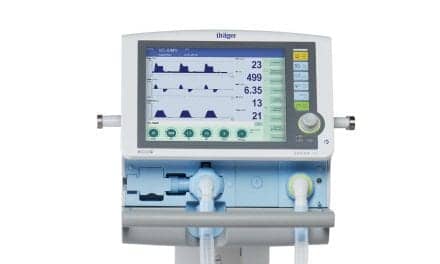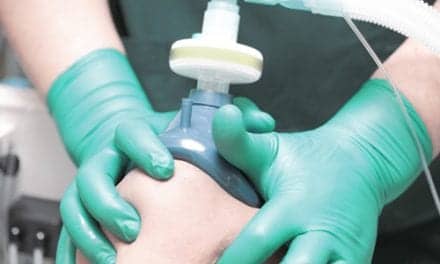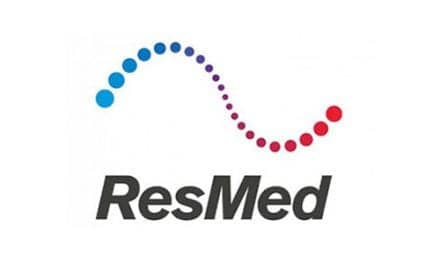RT/nursing collaboration, clinical guidelines, and the latest research and supporting technology for ventilator weaning.
By Winnie Sywulak, BS, RRT-NPS
While mechanical ventilation is a life-saving modality, when it is prolonged there is greater risk for patient complications, increased hospitalizations, and longer length of hospital and intensive care unit (ICU) stay.1-2
Furthermore, research shows patients on long-term mechanical ventilation can suffer post-traumatic stress disorder (PTSD) and other mental health issues. A study by Johns Hopkins found one in three people who survived ICU stays and required mechanical ventilation showed substantial PSTD symptoms that lasted for up to two years.3
In a recent presentation as part of a Dräger webinar, Karsten J. Roberts, MSc, RRT, RRT-ACCS, RRT-NPS, FAARC, director of Clinical Education, BS in Respiratory Therapy at Thomas Jefferson University, explored the critical role of respiratory therapists (RT) in decreasing the duration of mechanical ventilation through proven weaning practices.
“This is a topic that I feel very passionate about and one I think we as respiratory therapists should take ownership,” said Roberts. “When we start having conversations about value-added respiratory therapy, this is where we come into play, and this is where we really show our abilities as therapists to assess and make recommendations.”
RT/Nursing Collaboration
Roberts described the “Wake up and breathe protocol,” developed by Vanderbilt University Medical Center (VUMC). [iv] He explained how nurses and respiratory therapists collaborate during the weaning process, describing it step-by-step, including spontaneous awakening trials (SAT), sedation weaning, spontaneous breathing trials (SBT), and extubation with the ultimate goal of liberation from mechanical ventilation.
He noted how every 24 hours, the nurse should think about criteria for weaning sedation (e.g., patient off paralytics, no myocardial infarction, etc). He further explained that if the patient meets these criteria, then it is probably safe to screen for SAT. Once SAT screening is performed, sedation is weaned, and the nurse assesses the patient’s ICU Confusion Assessment Method (CAM) score (eg, anxiety, agitation, pain). If the patient fails the CAM assessment, then the nurse restarts sedation at half the dose and performs a SAT later.
As for the RT aspect of weaning, when the patient passes the SAT and sedation is weaned to the point where the patient is comfortable and not agitated on the mechanical ventilator, then the RT can assess criteria for SBT (eg, little to no agitation, SpO2 greater than 88%, etc). If the patient fails the SBT screening, they are returned to full mechanical ventilation support until ready for the next SBT (as Roberts commented, perhaps the next day).
Roberts presented data showing how the combination of SAT and SBT resulted in 3.1 fewer days on mechanical ventilation, reduced necessity of tracheostomy and lower risk for delirium.5
“We as respiratory therapists are working together in concert with our nursing colleagues to wean sedation and to get the patient off the ventilator as soon as possible. This profoundly decreases the risk of mortality and trauma that patients may experience from prolonged mechanical ventilation,” said Roberts.
Clinical Guidelines and Recommendations
Roberts provided a high-level overview of weaning guidelines from the American Thoracic Society (ATS) and American College of Chest Physicians (ACCP), along with clinical studies that support various weaning recommendations. He offered data – some in support, some against – various weaning strategies, including:
- SBTs conducted with/without inspiratory pressure augmentation
- Acute patient protocols to minimize sedation
- Extubation to preventative noninvasive ventilation (NIV)
- Early mobilization of acute patients ventilated for 24+ hours
- Mechanical ventilation liberation protocols
- Cuff leak tests for those with high extubation risks
- Administration of systemic steroids following extubation
- Vasopressor use during extubation and after discontinuation of mechanical ventilation
- Rapid shallow breathing index (RSBI) to gauge extubation success
- NIV versus high flow oxygen therapy use post extubation
- Standard RT assessment tool versus automated monitoring alert
Vasopressor Use and Discontinuation
Roberts explored the impact of vasopressors on extubation outcomes, citing research published in the May 2022 American Journal of Respiratory and Critical Care Medicine. Patients who were extubated while on high-dose vasopressors faced a greater hazard of reintubation, while extubation while on low-dose vasopressors was associated with a lower mortality rate and shorter ICU length of stay.6
Rapid Shallow Breathing Index (RSBI)
Commenting on the RSBI index, Roberts said research has shown that it is not specific enough to be used regularly to gauge extubation success. He cited the results of a systematic review and meta-analysis on the accuracy of RSBI in the prediction of successful extubation published in the January 2022 edition of CHEST.7 The researchers concluded that “as a stand-alone test, the RSBI has moderate sensitivity and poor specificity for predicting extubation success.”8
Noninvasive Ventilation Versus High-flow Oxygen Therapy
Roberts questioned whether clinicians should be using non-invasive ventilation (NIV) or high-flow oxygen therapy (HFOT) for post-extubation care. To answer this question, he looked to a multicenter randomized controlled trial published in the July 2017 Annals of Translational Medicine.9 Researchers studied 204 patients with respiratory failure admitted to emergency departments and requiring NIV, 39% of whom had COPD.
The study indicated that HFOT appears more tolerable than NIV, and NIV should not be used in low-risk patients (except for COPD patients). The effect of PCO2 over time was similar for HFOT and NIV across the entire study population.
Post-extubation Monitoring
With regards to post-extubation monitoring methodologies, Roberts presented research published in the October 2022 edition of Respiratory Care that evaluated the effect of a standard RT assessment tool versus an automated continuous monitoring alert to initiate post-extubation RT-driven care. While there were no significant differences in outcomes or costs when comparing the two methodologies, using an automated continuous monitoring alert saved RT time.10
How to Succeed with ATS and ACCP Ventilator Liberation Guidelines
An ATS and ACCP guidelines panel made five conditional recommendations related to rehabilitation protocols, ventilator liberation protocols, and cuff leak tests for acutely ill adults who are hospitalized and on mechanical ventilation for more than 24 hours.11-12
Summaries of these recommendations are below. Under each recommendation are criteria offered by Dräger for selecting ventilator technology that aligns with the guidelines.
Recommendation #1: For acutely hospitalized patients ventilated more than 24 h, we suggest that the initial SBT be conducted with inspiratory pressure augmentation (5-8 cm H2O) rather than without (T-piece or CPAP)
Conduct the initial SBT with inspiratory pressure augmentation rather than T-piece or CPAP.
The committee wrote that conducting the initial SBT with pressure augmentation was more likely to be successful, produced a higher rate of extubation success, and was associated with a trend toward lower ICU mortality (ibid, pg. 162).
Technology criteria
The ventilator should easily facilitate SBTs and close monitoring of patients for acute changes that may indicate their ability to be discontinued from mechanical ventilation. The technology should allow for immediate, early detection of intolerance should the patient’s condition deteriorate. Tools such as P.01 measurements, RSBI, and data trending can support the monitoring of spontaneous breathing.
Recommendation #2: For acutely hospitalized patients ventilated for more than 24 hr, we suggest protocols attempting to minimize sedation
Implement protocols to help minimize sedation. The committee found that sedation protocols reduced ICU length of stay. However, the protocols did not appear to decrease time on the ventilator or reduce short-term mortality. The authors could not recommend one protocol over another but said the burden of providing sedation by any of the protocols was “very low” (ibid pg. 163).
Technology criteria
Patient-ventilator synchrony remains key for keeping sedation to a minimum. Select a ventilator with features that contribute to this synchrony, such as an open breathing system with active exhalation valve, Autoflow and room-to-breathe. Moreover, a ventilator with automatic tube compensation (ATC) can alleviate the work of breathing imposed by an artificial airway.
Recommendation #3: For patients at high risk for extubation failure who have been receiving mechanical ventilation for more than 24 hr and who have passed an SBT, we recommend extubation to preventive NIV
Transition patients at high risk for extubation failure who have passed a SBT to preventative NIV. The committee found evidence that transitioning to NIV reduced ICU length of stay and short- and long-term mortality. The authors emphasized that in these patients, NIV should begin immediately after extubation “to realize the outcome benefits” (ibid pg. 163).
Technology criteria
Select a ventilator that can provide invasive, noninvasive, and O2 therapy with one device. Using one ventilator can reduce the cost of consumables and minimize the need for multiple pieces of equipment at the bedside. Additionally, it should have the capability to record all changes electronically with transfer to an electronic medical record (EMR).
Recommendation #4: For acutely hospitalized adults who have been mechanically ventilated for >24 hr, we suggest protocolized rehabilitation directed toward early mobilization
Implement rehabilitation protocols directed toward early mobilization. The committee wrote that patients receiving the intervention spent less time on the ventilator and were
more likely to be able to walk when they left the hospital. However, their mortality rate appeared unchanged. The authors noted that the exercises created additional work for ICU staff that might have come at the expense of other care priorities (ibid pg. 163).
Technology criteria
Ventilators with integrated compressors or turbines, O2 tank restraints, and battery power allow patients to walk with assistance.
Recommendation #5: We suggest managing acutely hospitalized adults who have been mechanically ventilated for >24 hr with a ventilator liberation protocol
Manage patients with a ventilator liberation protocol. The committee said that patients managed by protocol spent on average 25 fewer hours on mechanical ventilation and were discharged from the ICU a day early. However, their mortality rate appeared unchanged.13
Technology criteria
Choose technology that takes a proactive and uniform approach to weaning patients from mechanical ventilation. While facilitating the monitoring of patient parameters such as RR, TV, and EtCO2, the ventilator should gradually reduce the pressure support level safely and effectively – without the permanent need for a clinician at the bedside. When the patient is potentially ready to be extubated, a SBT can be started and the clinician is notified.
RTs: Trust your Experience, Consider the Patient
Roberts urged RTs to use their own expertise and knowledge in accordance with the guidelines. He posed the example of assessing patients for liberation of mechanical ventilation, where standard criteria for a SBT readiness include oxygen saturation, positive end-expiratory pressure (PEEP) and fraction of inspired oxygen (FiO2), stating:
“I’ve seen documented in charts that the patient was not ready for a SBT because they were on 50% of oxygen concentration and on a PEEP of 7.5. So, what’s the problem? The guidelines we use in my institution say, “less than or equal to,” which means it can be equal to 50% and PEEP can be 7.5. Even in your morbidly obese patients you may see PEEP a little higher than that and the patient is still eligible for SBT. We shouldn’t let these things limit us too much in terms of when patients are ready for SBT.”
While Roberts stressed the importance of clinical guidelines in helping RTs take the best course of action when weaning patients off mechanical ventilation, he also acknowledged how every patient is different. He described how the process of weaning can differ widely from patient to patient based on their condition:
“In my opinion, we are seeing a more individualized approach to our mechanically ventilated patients. Not every patient is the same and not every time we liberate a patient from mechanical ventilation should it be the same.”
Winnie Sywulak, BS, RRT-NPS, is senior marketing manager for Respiratory Care Solutions for Dräger in North America, an international leader in the fields of medical and safety technology. For more information, contact [email protected].
References
- Haribhai S, Mahboobi SK. Ventilator Complications. [Updated 2022 Sep 26]. In: StatPearls [Internet]. Treasure Island (FL): StatPearls Publishing; 2022 Jan-. Available from: https://www.ncbi.nlm.nih.gov/books/NBK560535/, https://www.ncbi.nlm.nih.gov/books/NBK560535/
- Overview: Getting Patients Off the Ventilator Faster: Facilitator Guide, AHRQ Safety Program for Mechanically Ventilated Patients. Available here.
- PTSD Symptoms Common Among ICU Survivors, Johns Hopkins, February 26, 2013, https://www.hopkinsmedicine.org/news/media/releases/ptsd_symptoms_common_among_icu_survivors
- ‘Wake Up and Breathe’ Strategy Allows Patients to Come Off Ventilator Sooner, Vanderbilt University Medical Center, May 17, 2007. Available here.
- Girard TD, Kress JP, Fuchs BD, Thomason JW, Schweickert WD, Pun BT, Taichman DB, Dunn JG, Pohlman AS, Kinniry PA, Jackson JC, Canonico AE, Light RW, Shintani AK, Thompson JL, Gordon SM, Hall JB, Dittus RS, Bernard GR, Ely EW. Efficacy and safety of a paired sedation and ventilator weaning protocol for mechanically ventilated patients in intensive care (Awakening and Breathing Controlled trial): a randomised controlled trial. Lancet. 2008 Jan 12;371(9607):126-34. doi: 10.1016/S0140-6736(08)60105-1. PMID: 18191684.
- Zarrabian B, Wunsch H, Stelfox HT, Iwashyna TJ, Gershengorn HB. Liberation from Invasive Mechanical Ventilation with Continued Receipt of Vasopressor Infusions. Am J Respir Crit Care Med. 2022 May 1;205(9):1053-1063. doi: 10.1164/rccm.202108-2004OC. PMID: 35107416.
- Trivedi V, Chaudhuri D, Jinah R, Piticaru J, Agarwal A, Liu K, McArthur E, Sklar MC, Friedrich JO, Rochwerg B, Burns KEA. The Usefulness of the Rapid Shallow Breathing Index in Predicting Successful Extubation: A Systematic Review and Meta-analysis. Chest. 2022 Jan;161(1):97-111. doi: 10.1016/j.chest.2021.06.030. Epub 2021 Jun 26. PMID: 34181953
- Trivedi V, Chaudhuri D, Jinah R, Piticaru J, Agarwal A, Liu K, McArthur E, Sklar MC, Friedrich JO, Rochwerg B, Burns KEA. The Usefulness of the Rapid Shallow Breathing Index in Predicting Successful Extubation: A Systematic Review and Meta-analysis. Chest. 2022 Jan;161(1):97-111. doi: 10.1016/j.chest.2021.06.030. Epub 2021 Jun 26. PMID: 34181953.
- Frat, J.-P & Coudroy, Rémi & Marjanovic, Nicolas & Thille, Arnaud. (2017). High-flow nasal oxygen therapy and noninvasive ventilation in the management of acute hypoxemic respiratory failure. Annals of Translational Medicine. 5. 297-297. 10.21037/atm.2017.06.52, Available here.
- Kaur R, Vines DL, Harnois LJ, Elshafei A, Johnson T, Balk RA. Identification and Prevention of Extubation Failure by Using an Automated Continuous Monitoring Alert Versus Standard Care. Respir Care. 2022 Oct;67(10):1282-1290. doi: 10.4187/respcare.09860. Epub 2022 Mar 28. PMID: 35347080.
- Fan E, Zakhary B, Amaral A, McCannon J, Girard TD, Morris PE, Truwit JD, Wilson KC, Thomson CC. Liberation from Mechanical Ventilation in Critically Ill Adults. An Official ATS/ACCP Clinical Practice Guideline. Ann Am Thorac Soc. 2017 Mar;14(3):441-443. doi: 10.1513/AnnalsATS.201612-993CME. PMID: 28029806.
- Liberation From Mechanical Ventilation in Critically Ill Adults, Executive Summary of an Official American College of Chest Physicians/American Thoracic Society Clinical Practice Guideline, CHEST, January 2017. Available here.
- Fan E, Zakhary B, Amaral A, McCannon J, Girard TD, Morris PE, Truwit JD, Wilson KC, Thomson CC. Liberation from Mechanical Ventilation in Critically Ill Adults. An Official ATS/ACCP Clinical Practice Guideline. Ann Am Thorac Soc. 2017 Mar;14(3):441-443. doi: 10.1513/AnnalsATS.201612-993CME. PMID: 28029806.










